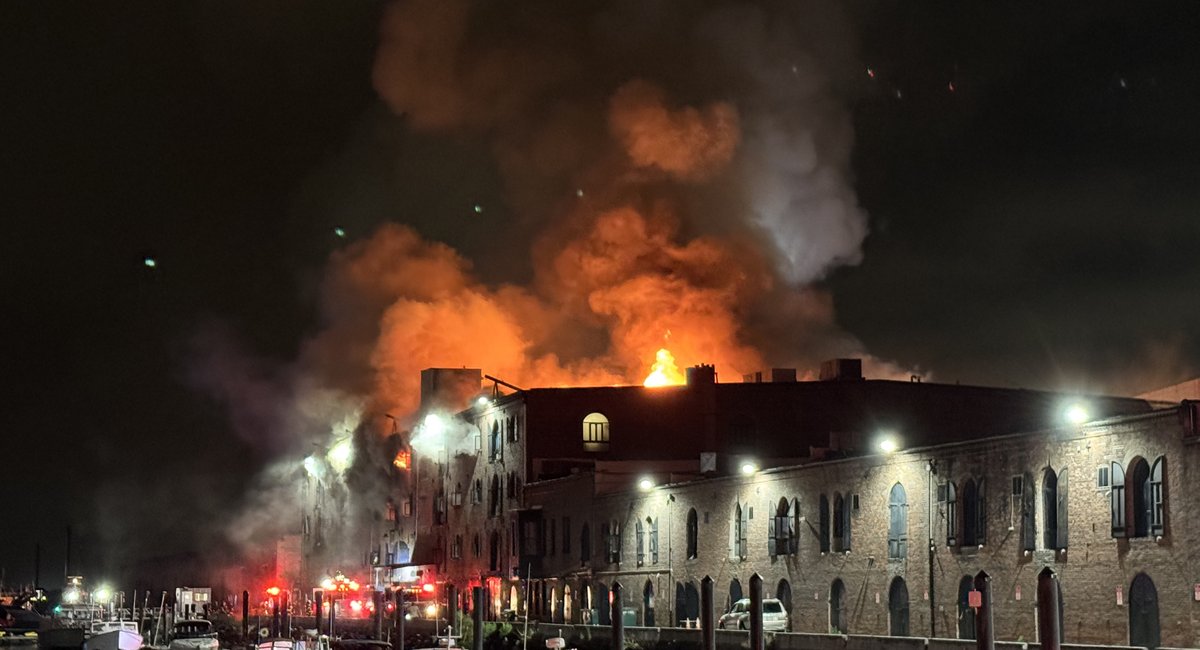It’s been well over a month since a five-alarm fire consumed a four-story warehouse in Red Hook, Brooklyn, that had long been a rare affordable haven for many independent artist studios.
But tenants are now not only unsure of the building’s future but also of its present: Access since the fire has been extremely limited, and some haven’t been allowed back in even once, leaving them unsure what – if any – of their in some case’s life’s work is recoverable.
If fire damage were the only concern, access might feel less urgent, but firefighters used “the equivalent of 10 continuous years of rainfall” to put out the blaze, said 12-year building tenant Justin Neely, a “polyglot artist” whose work prominently features contour drawing and collage.
Although Neely’s studio wasn’t damaged by the flames, he said it still looked like it was a set in “a kind of horror movie” when he was first allowed to visit it two weeks after the fire.
“That’s really the only analogy I have for the sorts of mold growth and decay setting in and taking hold so comprehensively, extensively and revoltingly,” he said.
Neely was unsure how toxic the damaged art he removed was and rented a space to store it in Sunset Park. Some of those items are “now blooming” with mold, he said.
Since the fire, he said, he and the studio’s 11 other residents have been allowed to access the space for approximately four hour time blocks on four separate occasions during which they’ve needed to share access, with a maximum of four people admitted to their studios concurrently. He said he can only imagine how bad the mold in his studio has gotten since.
“Whatever could have been salvaged in the beginning might just not be at this point. And so I feel defeated,” said Adela Wagner, a multidisciplinary artist who has had a studio in the building for two years. “ I’m not sure why our floor has not been cleared yet for access [when] others were,” she said, but she hasn’t had access since the Sept. 17 blaze and has begun to assume the worst.
“The work that I’ve lost is about 13 years of archival work,” she said.
Wagner says she remains perpetually ready to return to her studio once granted access.
“It feels like I’m on my tippy toes,” Wagner said. “I have a box of supplies – full-face respirator, Tyvek suit, bags, whatever else I might need if I can retrieve some stuff. I just have it and I’m standing by.”
For sculptor Tom Beale, a building tenant of two-and-a-half years, not being able to access his studio has felt especially surreal because he actually entered the building during the fire, made a few small adjustments to ensure the safety of some items in the space, then left when the smoke got bad, confident he’d be able to return soon.
“I covered a desk I had just finished building for a friend, and several of my sculptures,” Beale recalled. “I took a few framed drawings off of the wall and put them under the desk. It was an uncanny experience, as everything seemed calm and just as it was when I was in the studio less than an hour-and-a-half before, absent the thick smoke.”
He felt confident “everything would probably be alright” and left. He didn’t think to take anything with him.
“In the days and weeks following, it has been a deeply frustrating experience of being told different things by different entities,” said Beale, whose studio was not reached by the flames, but is near a partial roof collapse. “We have alternately been told we would be allowed entry for only 15 minutes with an escort, that we would be granted full access, that there is serious mold, that the mold is not so bad on our floor, that we should consider it a total loss, that many things are likely salvageable.”
The full extent of the fire’s damage, as well as its cause, remain under investigation, FDNY confirmed. As of this writing, all portions of the complex are under full or partial vacate orders.
Meanwhile, “all of our personal, valuable things have been left to sit and rot” said Beale.
In response to a request for comment from building owner the O’Connell Organization, CEO Gregory T. O’Connell said he empathizes deeply with tenants but must prioritize “safety and full compliance with City agency directives” restricting access.
“I’ve communicated personally with all tenants and fully understand their frustration with waiting for meaningful access and answers,” O’Connell wrote in an email. “We are doing everything within our control to broaden access permissions so that tenants may recover all salvageable items.”
Shortly after Gothamist reached out for comment, multiple tenants received notice of new retrieval windows, an “about face from the previous communication,” said Neely.
Even more than access to what remains of her studio space and work archive, though, Wagner hopes that she and other artists can eventually return to working in the space full-time. But she fears the affordable artist haven that has existed here will become just another relic of a bygone New York City.
“I worry that people will move on and forget about this building, forget that it ever existed,” she said. “My dream would be for people to bond together and maintain the building and bring artists back into it.”

